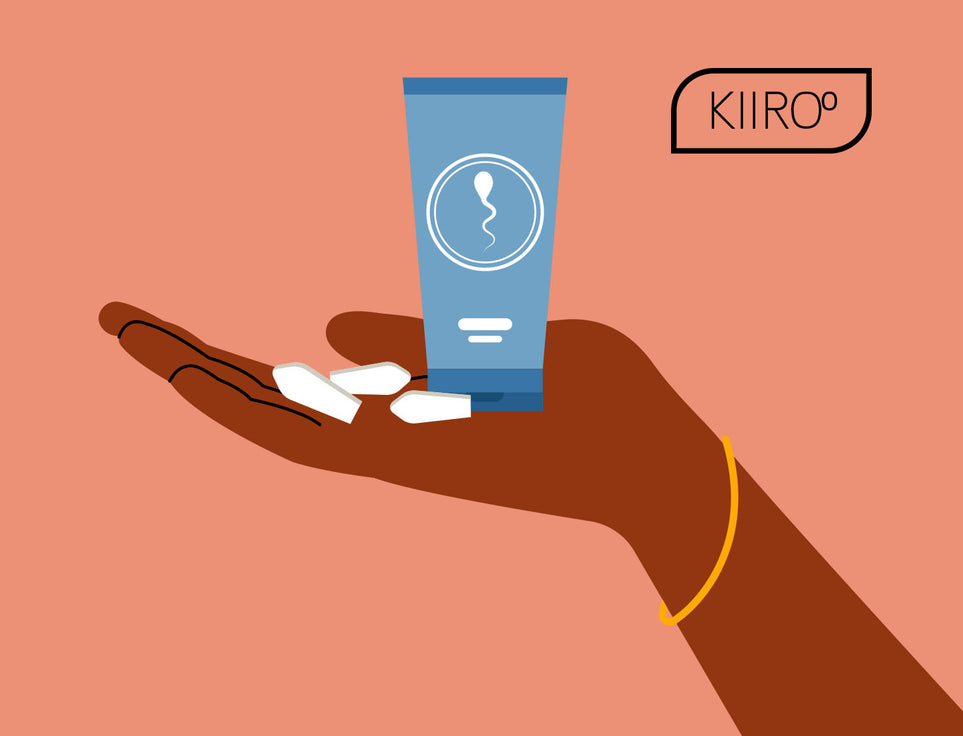With endless options of contraceptive methods available to us to increase our fertility awareness, it can be challenging to understand what form of contraceptive is best for you.
When looking for an effective form of contraception, it’s important to know your options.
You may have heard of spermicidal lubricant before, but do you know what it is? How it works? Is it effective? Is it normal lube?
If you’re full of these questions, you’re going to get the answers to them in this article. In the guide, you will learn everything about spermicidal lubricant, so you can decide whether it’s right for you.
What is Spermicidal Lubricant?
Spermicidal lubricant, also known as spermicide, is a contraceptive that has been used for thousands of years — literally. It’s a nonprescription form of birth control that uses chemicals like nonoxynol-9 (N-9) to prevent sperm from reaching the egg.
In other words, it kills the semen on contact after ejaculation, while also acting as a physical barrier. For it to be effective, spermicide is inserted into the vagina up to 30 minutes before sexual intercourse.
There are various pregnancy methods of birth control such as vasectomy, male condoms, female condoms, birth control pills, abstinence, the morning-after pill, and more.
Spermicide is clear, unscented, unflavored, non-staining, and lubricative. Its lubricated feature is a benefit to many since it acts as both a contraceptive and lubricant.
However, spermicide can come in other forms like male condoms, suppositories, sponges, film, and foams.
What is Nonoxynol-9?
The chemical used in most spermicides is nonoxynol-9 (N-9), a common surfactant, that inhibits sperm movement and kills the sperm before contact with the egg.
Spermicides are non-hormonal contraceptives (which is why you can purchase them without a prescription).
N-9 has been used for over thirty years as an over-the-counter drug, present in creams, foams, gels, and condom lubricants.
It’s important to know that nonoxynol-9 does not protect against HIV/AIDS or other sexually transmitted infections/diseases STDs.
How does spermicide work?
As you just learned, spermicide is inserted into the vagina before sex and contains chemicals that kill sperm before reaching the egg. But what does that mean?
Spermicide prevents pregnancy in two ways: It blocks the entrance to the cervix, prevents sperm from reaching the egg, and stops sperm from moving successfully to the egg.
The chemical nonoxynol-9 works by damaging the cell membrane of sperm, which interferes with its ability to swim to the egg.
How accurate is spermicidal lubricant?
When choosing the right contraceptive, you want to be aware of its effectiveness in preventing pregnancy.
In the US, the belief is 18 out of 100 women who use spermicide become pregnant each year — even when using it correctly. However, we’re humans, and mistakes happen.
In reality, the numbers are a bit different. Around 21 out of 100 women who use spermicide become pregnant. This means spermicide is approx. 79% effective in preventing pregnancy.
Using spermicide alone isn’t the most effective way to prevent pregnancy; however, using it with another form of contraception, like condoms or birth control pills (which is 88% effective), can improve the odds. When combining spermicide with another form of contraception, you can reduce the failure rate to 2.5%.
How to Use Spermicide
If you’re considering spermicide as your choice of contraceptive method, it’s important to learn how to use it properly. Inserting spermicide into the vagina is as if you’re putting in a tampon.
So, you can either insert it while lying down, squatting, or standing with one foot on a chair, whatever is most comfortable for you. You want to make sure you insert the spermicide deeply into the vagina for maximum protection.
Now, before you get too excited, spermicide needs time to activate. You want to insert it 15-30 minutes prior to having sex. If you’re in the heat of the moment, you’re better off using a latex condom, as spermicide needs time to work.
However, you can also use a condom and spermicide together — spermicide will not damage condoms.
Unfortunately, there is a time limit to spermicides, as they only last around 60 minutes. However, if you’re going to have sex multiple times, you simply add more spermicide deeply into the vagina.
What’s important to know is spermicide should be left in place for six to eight hours after sexual intercourse for full protection. If that’s not ideal for you, then consider other options.
Where to buy spermicidal lubricant?
Because spermicide is non-hormonal, you do not need a prescription for it. This means you can purchase it over-the-counter at pharmacies, drugstores, or online. Additionally, family planning clinics may also provide them.
Spermicide prices range depending on brand and type; however, it can cost between 60 cents to $3 per dose. You can also purchase them in kits.
Can anyone use spermicide?
All women can safely use spermicides, as they do not have any effects on the male or female reproductive cycle, except for the following:
- Women who are high risk for HIV infection
- Women who have HIV
What are the disadvantages of using spermicide?
The biggest issue with spermicide is they’re considered to have the highest failure rates among contraceptives. While the numbers don’t lie, there are multiple reasons for this.
Two common reasons for its high failure rates is due to insufficient amounts of spermicide being inserted into the vagina, or not inserting it deeply enough into the vagina.
It’s extremely important to read the instructions on the box and follow the instructions for full effectiveness.
Another reason for failure is due to not waiting the recommended time between insertion of spermicide and intercourse. Who wants to sit and wait? I get it.
However, not waiting a minimum of 15 minutes before sexual intercourse means the spermicide may be inactive.
Lastly, spermicide does not protect against STDs or HIV/AIDS. So, suppose you’re looking for a contraception that will prevent pregnancy and protect against sexually transmitted diseases.
In that case, we recommend you use a condom along with your spermicide, or choose another contraceptive.
While there are disadvantages to spermicide, many of them are connected to not using the contraceptive properly. We highly recommend following the instructions on the box, or consulting with a medical professional for assistance.
WRITTEN BY
Natasha Ivanovic
Natasha Ivanovic is an intimacy, dating, and relationship writer best known for her writings on Kiiroo, LovePanky, Post Pravda, and more. She's the creator and author of her short stories on TheLonelySerb. She completed her first degree in Criminology and continued and finished her Masters in Investigative Psychology, but then decided to follow her true passion of writing.





























